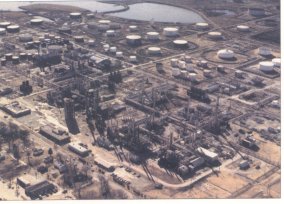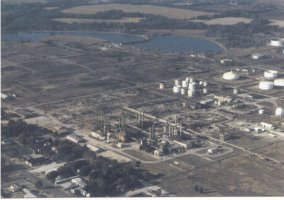|
No one marched seven times around and there was no
sounding of trumpets, but our Augusta, Kan., refinery -- the inactive
portion -- has come tumbling down.
More than 2,000 rounds of explosives have been used to demolish
enormous chimneys, towers and massive concrete foundations.
|
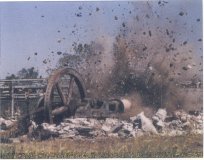
|

|
|
Concrete and brick flew as building,
towers and chimneys were dynamited. |
One of more than
100 buildings torn down on the refinery site |
For more than a year, as many as 10 big pieces of rubber-tired or
tracked equipment and 50 workers battered, cut, scooped and hauled
concrete, metal and wood from the 440 acre complex six days a week. Most
of the demolition was concentrated in a 140 acre area about the size of
70 city blocks.
|
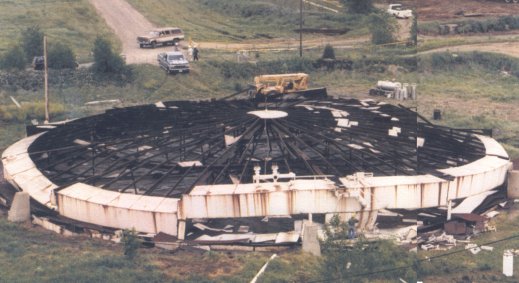
|
|
Contract crews demolish one of more than 100
steel storage tanks -
the largest having a 75,000 barrel capacity.
Our largest tank farm - Des Moines - has 52 tanks |
Past finds of ancient pottery suggest that Indians may have inhabited
the area some 3,000 years ago. Oil was discovered in 1910.
The Augusta Field boasted some 200 oil and gas wells seven years
later, when fledgling White Eagle Oil Company started construction of
the refinery. The oil company and refinery were named for a chief of the
Ponca Indians.
During the Roaring '20s, the refinery grew in size and
sophistication. And, with it, White Eagle Oil (and Refining) Company
grew in market share of the Midwest.
By 1930, White Eagle became an attractive acquisition for Standard
Oil Company of New York (Socony). Through further acquisitions, mergers
and name changes, Socony became Mobil Oil Corporation. All the while,
the Augusta Refinery continued to grow.
From a 7,000 barrel per day capacity in 1924 and a crew of fewer than
100, the refinery expanded in the '60s to a peak capacity of more than
50,000 barrels per day and more than 500 employees, producing numerous
grades of gasoline and distillates and a fine line of asphalts.
During its heyday, the refinery boasted the tallest structure in
Kansas a state of the art Thermofor Catalytic Cracking (TCC or
catcracker) unit that stood some 300 feet tall.
El Dorado, Kan., Area Supervisor Will Prater recalls the windy night
he climbed all the way to the top of the catcracker - twice - to replace
the 100 watt light bulb used to alert pilots of the structure.
"It was a Friday night and I couldn't find anyone else to do
it," he says. "I climbed up the first time, found the light
fixture, removed the old bulb and thought I had it made. My hands were
so shaky that I dropped the new bulb and had to climb down for a second.
The wind must have been 40 miles per hour, and the top 25 feet of the
catcracker was a single-rung metal ladder."
Many townspeople turned out to see the bottom third of the TCC unit
crumble. The top two-thirds - all steel - had been removed years before.
Local firefighters rappelled the sky-tall structure and staged mock
fires in other buildings on site.
|
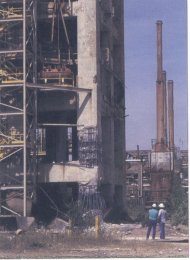
|
|
Demolition crews had to dynamite the TCC unit
twice before it fell.
Notice the number of steel rods which support the unit's leg. |
Most Augustans have ties to the old Mobil refinery. It put bread and
butter on a lot of tables. The annual payroll brought millions of
dollars into the community. It was common for refinery employees to
serve on the school board or in city management - even as mayor.
In 1983, Mobil shut down the facility and we acquired it as part of a
package that included several hundred miles of pipeline and terminalling
facilities.
Our original intent was to sell the refinery intact but after several
years of marketing efforts, we contented ourselves with selling
individual components.
Coastal Derby operated a portion of the refinery from 1986 until this
past fall - except for an 18 month period - producing unleaded gasoline
from blendstocks and feedstocks (naphtha and natural gasoline).
Finally in the spring of 1992, we began demolishing the inactive
portions. Williams Energy Ventures now has charge of the portion once
operated by Coastal.
The demolition project was done in part to rid the refinery of
potential asbestos hazard and improve the appearance of the area. The
plant site is next to the downtown business district.
All told, more than 4,000 cubic yards of asbestos containing material
(ACM) have been delivered to the Butler County landfill and covered by
another 10,000 cubic yards of earth. |
